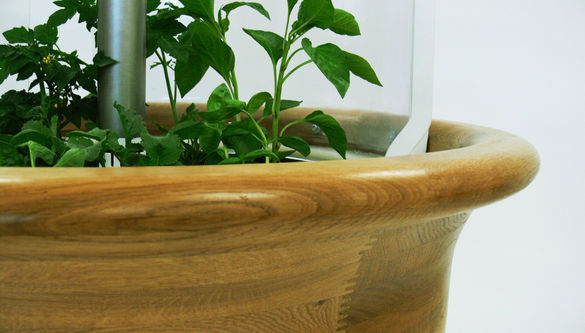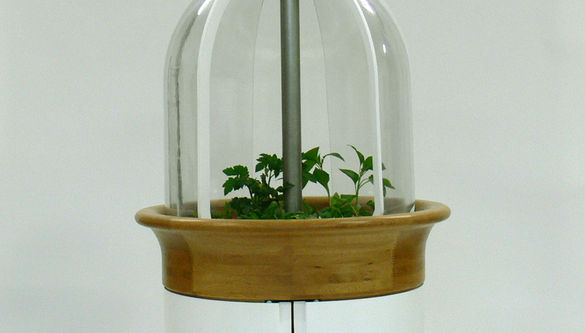Tončíková / portfolio
BIOCULTIVATOR
Biocultivator is the most important project that had a very personal meaning for me and with hindsight I consider it key not only for understanding the work with Biomimicry, managing a team, but also as a project that gradually opened the door for me among Biomimicry specialists and innovators. The beginning of the Biocultivator project dates back to 2015. This biomimicry project is the story of a design start-up that was created on academic grounds under the name Balcony Cultivator, but later transformed and its redesign development took place outside the academic environment.
In 2015, a call was issued on several design portals to expand the Biomimicry Global Design Challenge competition to include a category for professional designers focused on the topic of "Food system". The Biomimicry Global Design Challenge is the largest international competition focused on bio-inspired design. The category for professionals is interesting because it has two rounds. In the first round, participating teams submit project concepts. From all registered projects, 7 teams are selected, with which the Biomimicry Institute in the USA cooperates in the prototyping round during the following year through the created biomimicry accelerator.
A team of mentors and experts from various fields strives to work further with the winning projects to help them with prototyping and commercializing the proposed solution.
The following year, teams present the resulting projects to investors and professionals and compete against each other for the $100,000 Ray of Hope Prize.
The significance of the project can be seen on two levels. Professional from the designer's perspective and academic from the university teacher's perspective. The first represents the designer's experience with creating truly bio-informed design, with launching a demanding start-up focused on hardware development and understanding the pitfalls and benefits of teamwork. From the point of view of my academic and pedagogical development, the Biocultivator project started an incredible journey of professional and academic growth. I consider this level to be even more significant than the Biocultivator StartUp itself.

Biocultivator 2.0
DESIGN 2018 - 2019: BIOCULTIVATOR 2.0
The minimum viable prototype is designed to operate as passively as possible. The proposed product philosophy combines innovative design and modern science. The vision of the Biocultivator product is to bring back the tradition of growing vegetables to the balconies of residents of large cities in an innovative form. Its uniqueness lies in the combination of growing, composting and self-irrigation in one innovative, design and ecological product. The product is designed to ensure the recycling of all input elements (water, kitchen waste, plants), which are subsequently returned to the consumer in the form of fresh humus, fertilizer and crops. This cycle means that the user inserts nutrients into the system in the form of kitchen bio-waste (peels, tea bags, coffee grounds, shells, moisture...). The composter processes these nutrients into humus and fertilizer, which we will use in the upper growing part and the nutrients will return to us in the form of a grown product. It functions as a separate sustainable ecosystem on the balcony. The product is not only designed as part of biophilic interiors, but directly connects the user with the product's ecosystem. The goal was not to eliminate the user's work and care for plants, but to create a system where a person can occasionally get their hands dirty, but which can survive for a while without it.
Another basis of the technology is the ability to grow nutritious food by growing it in real soil, unlike popular aeroponic and hydroponic systems, where plants have no way to develop a rich root system. The device in this basic form works passively and is able to automatically regulate the temperature in the dome, open and close the ventilation holes. Earthworm compost also has the great property that their population grows purely depending on the size of the space they have and the amount of food they are given. As long as the user does not produce a lot of bio-waste, this does not mean that the earthworms are starving, their population will just naturally decrease and adapt.
The product is still under development in 2019. Several versions of the Bio-cultivator have been created. The project is in the proof-of-concept phase and is testing the first functional prototype.
Biocultivator 2.0 Team:
Zuzana Tončíková (design & biomimicry), František Tóth (prototyping and technical design solutions), Miroslav Chovan (graphic design), Dávid Jurík (technical support)
BIOCULTIVATOR 2.0
EXHIBITIONS
PROJECT AWARDS
TECH FEST 2019 - 5. 6 2019, Bratislava – Slovakia
Slovakia Going Zero Waste 6. – 7.4 2019 Bratislava – Slovakia
Alphabet of Life – Nature's Learning Lab, Exhibition June 23 – October 6, 2018, Werkraumhouse Andelsbuch – Austria
Bioneers Conference 21.10.-22.10.2016, San Rafael, California, USA
Technology Showcase, 20.10. 2016, Children's creativity Museum, San Francisco, USA
Living Product Expo 2016; Living Product Institute, Pittsburgh, USA; (September 13 - September 15, 2016: Pittsburgh, Pennsylvania, USA
Biomimicry Global Design Challenge 2015 (opening October 4 - October 7, 2015: Austin, USA
Lady Bird Johnson Wildflower Center
EIT FOOD INNOVATION PRIZE 2019
Competition finalist
OPEN MAKER 2017-2018
grant competition for innovation-focused startups
DIPLOMATIC MISSION OF THE PRESIDENT OF THE SR A. KISK IN CROATIA
Croatian-Slovak innovation forum / Biocultivator selected by the Presidential Office and the SARIO – GOOD IDEA SLOVAKIA agency as part of the best innovative ideas, June 2017
STARTUP AWARDS 2016
Finalist in the top 3: Art&Design Category; Dec. 2016, SVK – Gala Evening (December 2, 2016, Bratislava).
RAY OF HOPE AWARD 2016
Best Design Award, Ray C. Anderson Foundation; October 2016, San Rafael, USA
BIOMIMICRY GLOBAL DESIGN CHALLENGE 2015; People's choice award; the Balcony Cultivator project
BIOCULTIVATOR 1.0
In 2016, we created a detailed technologically and structurally developed prototype - Biocultivator 1.0, in the form of a virtual prototype and a 3D printed scale model. From the point of view of Bio-inspiration, the heart of the product was still the dome, which we were not able to prototype with the given biomimetic properties due to the lack of finances and time. During the year, we managed to create only small samples of materials that seemed promising, but their development was very demanding for us. Self-irrigation was designed so that water obtained from air humidity flowed down the sides of the dome and was directed by a capillary system into a collection container placed under the pot. The water thus obtained would irrigate the plants using hydroponics, through placed wicks connecting both containers. As we were still prototyping the concept, our visions considered both a biomimetic polycarbonate dome, but also the use of photovoltaic cells placed on top of the dome, which would provide energy for the Respozio device - automatically monitoring the status of the Biocultivator and sending information directly to the user's smartphone.
This was also how the automatic opening and closing of the dome was to be controlled. The flow of moisture in the system, as well as ventilation, was to be controlled based on the passive physical principles of the chimney effect and condensation. A storage space for tools was created in the lower part of the device and humus was created, which would have time to mature before use. The biocultivator was also designed to use natural chemical and physical principles to the maximum extent for its functioning.









